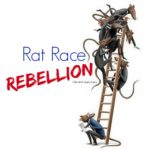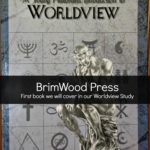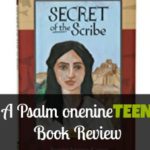I was intrigued when I was offered the opportunity to review this curriculum, A Young Historian’s Introduction to Worldview, published by Brimwood Press. Being Messianic, I was a bit worried and wondered how hard it would be teach my children using a traditional Christian curriculum, since so many have a denominational slant or perspective. My Brimwood Press Worldview Curriculum Review will also include a link to the review bymy thirteen year old son of the book, The Secret of the Scribe. Be sure to click through and read that as well!
Why should we teach a biblical Worldview to our children? Because we interpret our whole world through our worldview glasses. Every major life question is filtered through those lenses, as well as every minor one. Questions like “Where did man come from?”, “Why do bad things happen to good people?”, “What happens to me when I die?”. Every struggle, tragedy, joy and triumph is seen through those same worldview glasses. It impacts every aspect of our lives… our views, our relationships, our wants, our desires and our priorities… so it’s pretty important to spend some time with our children talking about worldviews.
How does this curriculum teach this subject? A Young Historian’s Introduction to Worldview is only four chapters long and is the beginning of their worldview curriculum product line. The four lessons focus on:
- defining the concept of worldview
- identifing what all worldviews have in common
- providing a tool to identify and understand the differences between the worldviews
- and looking at how worldview influences history
Each of the four lessons present hands-on activities, literature activities, thinking activities and discussion questions to help our children understand how a person’s worldview shapes their perspective of cultures, individuals, literature, history, art and entertainment. It explains how faith and philosophy are the foundation of a person’s worldview. The guide helps students understand the basic beliefs of four worldview families. The worldviews/faiths presented are: monotheism, polytheism, pantheism, and naturalism. Twelve different religions are discussed, contrasted and compared and then sorted into one of these four categories. and their are presented dispassionately, numerous opportunities are presented to discuss these concepts and solidify your family s values through Table Talk sections. Several hands-on activities are presented, including the construction of boxes (all materials provided) to graphically illustrate the differences in worldviews. These lessons are powerful, powerful, powerful! If you purchase the entire set of materials from Tools for Young Historians, it is recommended that you cover these four lessons first, as they give the student a lens through which to evaluate the rest of their study.
This curriculum is designed for children ages 10-13 or in 5th to 8th grades.
The first lesson begins with a brief introduction of the concept of worldview as “the lens through which people see and understand the world in which they live.” To reinforce the concept of seeing through different lenses, students are directed to the computer to view a geodesic picture on the publisher’s website. They complete an observation sheet viewing the geodesic picture with the naked eye, through sunglasses, and through 3-D glasses (provided in the bag). Next, students either read or listen to the story of Lensland that demonstrates how conflicting perceptions can have significant consequences. Lensland’s citizens divide into three groups: Twoeyes, Multieyes, and Thickeyes. As one might guess from their names, each group has different eyes and, consequently, views things differently. Their conflicting visual perceptions lead toward a clash that threatens the peace and tranquility of Lensland. The lesson then transitions back to the real world with two examples of authors’ writing about DNA demonstrating how different “lenses” influence how people might interpret the same information. Discussion questions are interspersed through the lesson, and it ends with Table Talk: Family Discussions Facilitated by Parents. This section might be used by the entire family even if they are not all involved in the rest of the lesson. It reviews key ideas from the lesson and raises questions for family discussion.
The rest of the lessons follow similarly creative formats. The second lesson teaches what all worldviews have in common—the important questions about the meaning of life and existence of God. The third lesson introduces a simple way to divide worldviews into four categories, using some very creative hands-on activities. The fourth lesson primarily uses stories and discussion to demonstrate the impact of beliefs in selected historical settings.
I particularly like the discovery approach used to lead students into worldview concepts. By raising questions and working through activities, students are led to explore their own beliefs and recognize the important questions they need to ponder. Because younger students are particularly susceptible to the influence of teachers, it makes the most sense to use this course within the family so there is opportunity to identify and discuss the family’s religious beliefs. Each family can then decide how far they wish to go in exploring alternative worldviews.
Brimwood Press has also published a series of four historical novels that can be used with students in this age group as a springboard for worldview discussions. The novels are set in different time periods—ancient, medieval, early modern, and modern–and feature characters with different worldviews: polytheism, monotheism, naturalism and pantheism. Titles are: Secret of the Scribe, The Jeweled Astrolobe, Beneath the Cat’s Claw, and Rebel on the Path. Brimwood should soon have available (by 2009) the Christian Readers Guide for Engaging Thinkers, a discussion guide for all four books.




Let's discuss.... comment and share your thoughts!